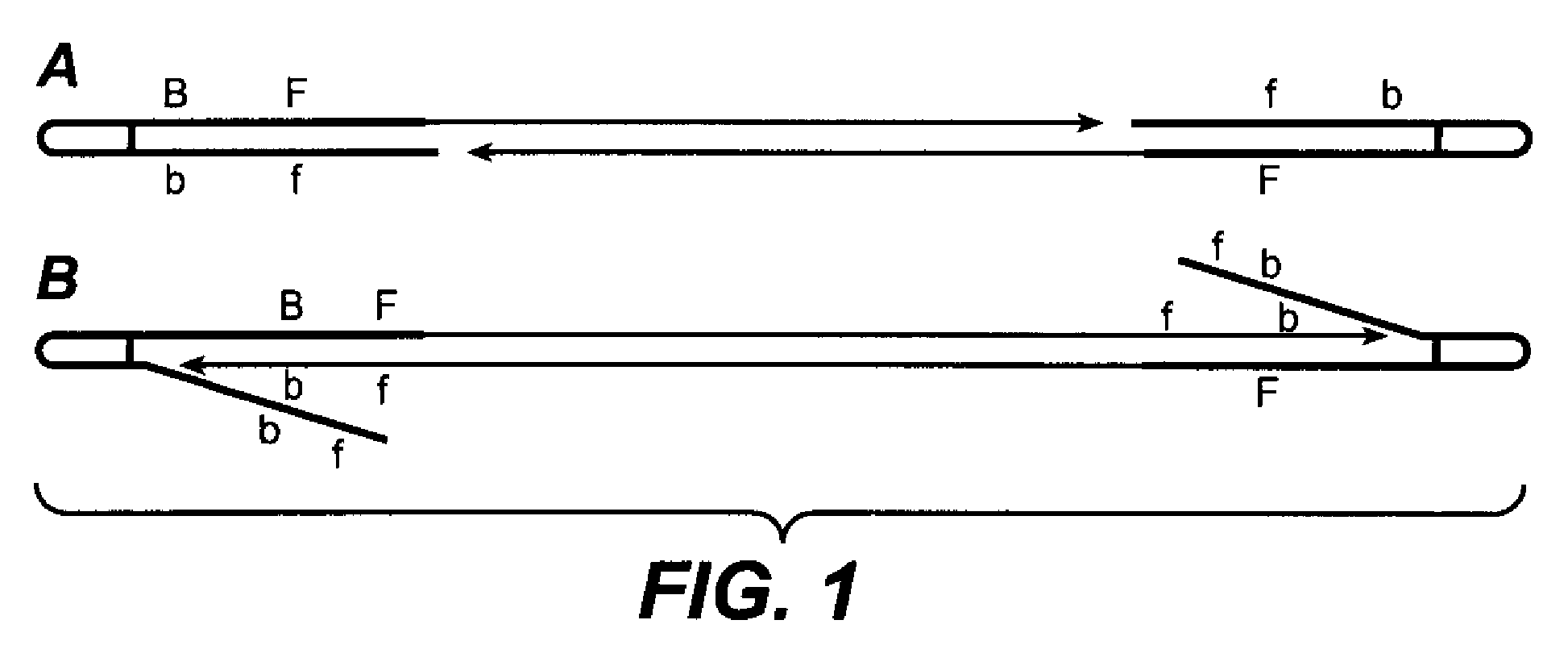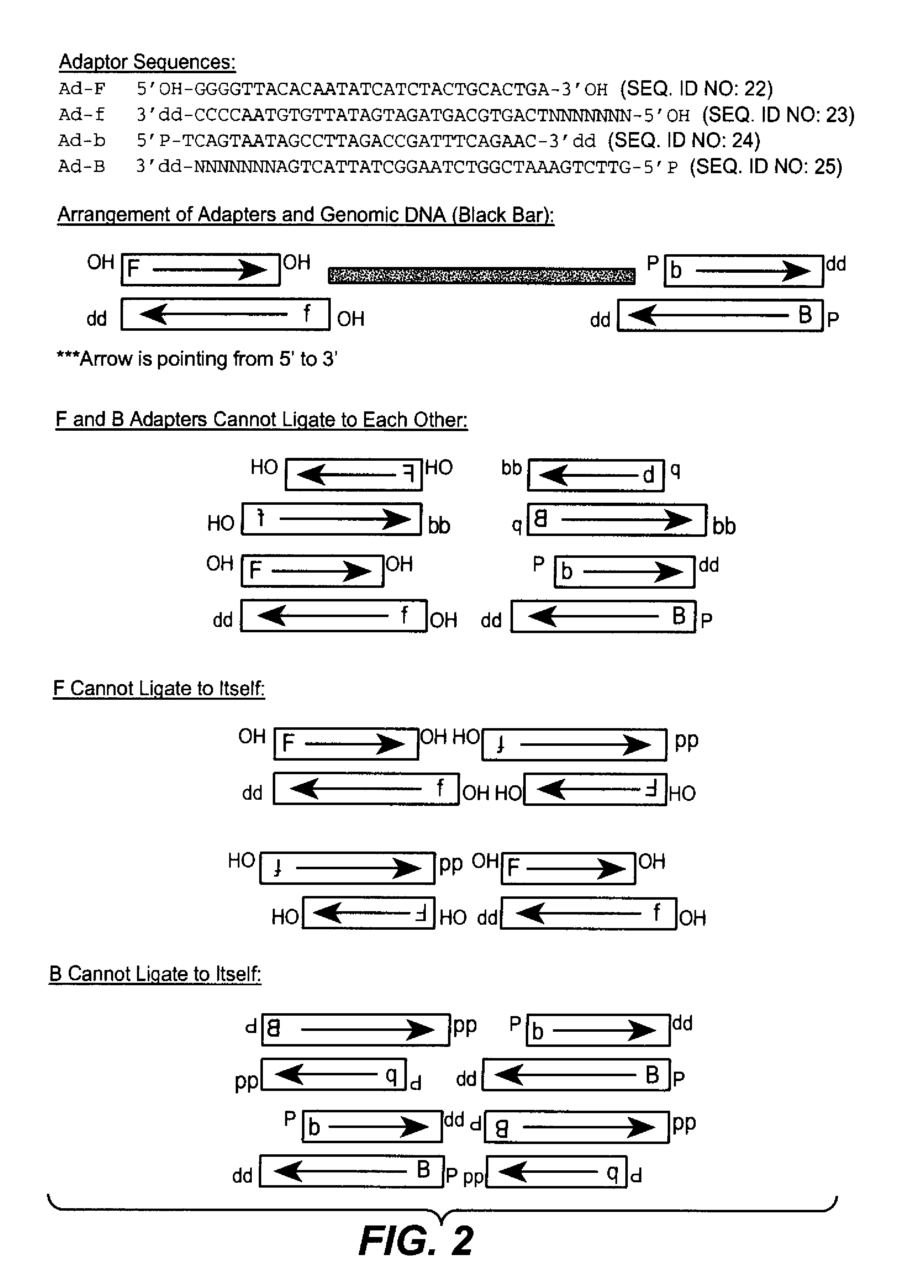Random array DNA analysis by hybridization
a random array and hybridization technology, applied in the field of methods for analyzing molecules, can solve the problems of insufficient versatility to address all pathogen detection problems, lack of sensitivity and versatility to detect and identify all potential pathogens in a sample, and the early development of molecular recognition technologies such as phage display, aptamers and small molecule ligands
- Summary
- Abstract
- Description
- Claims
- Application Information
AI Technical Summary
Benefits of technology
Problems solved by technology
Method used
Image
Examples
second embodiment
[0227]The method of the present invention allows for multiple mechanisms by which probes and IPPs are designed. In one embodiment, probes and IPPs are designed by varying the number of probes per pool, more specifically, in the range of 4 to 4096 probes per pool. In a second embodiment, probes and IPPs are designed by varying the number of pools per set, more specifically in the range of 4 to 1024 pools per set. Probes may have 2 to 8 informative bases providing a total of 4-16 bases. In yet another embodiment, probes are prepared as pools with degenerate synthesis at some positions. A further embodiment comprises having two assemblies of two sets of IPPs wherein different probes are mixed within one pool.
[0228]A small set of 20 to a few hundred probes can provide a unique hybridization signature of individual nucleic acid fragments. Hybridization patterns are matched with sequences to identify pathogens or any other nucleic acid, for example for counting mRNA molecules. One embodim...
experiment 1
[0284]B. Experiment 1
[0285]Hybridization / Ligation was carried out in a closed chamber at room temperature for 1 hour. The reaction solution contained 50 mM Tris, 0.025 units / μl T4 ligase (Epicentre, Madison, Wis.), and 0.1 mg / ml BSA, 10 mM MgCl2, 1 mM ATP, pH 7.8 and varying amount of ligation probe pools (see, Table 2) from 0.005 to 0.5 pmole / μl. After reaction, the slide was washed by 3×SSPE for 30 minutes at 45° C., then rinsed with ddH2O 3 times and spun dry. These slides were then scanned at Axon GenePix4000A with PMT setting at 600 mV.
TABLE 2Ligation probe poolsPool 1FM-poolSMM1-poolSMM2-poolTgt1-5′-probe5′-NNNTGTATG5′-NNNTGTAAG5′-NNNTGTATG(SEQ ID NO: 6)(SEQ ID NO: 7)(SEQ ID NO: 6)Tgt1-3-probe5′-CGTTGNN-*5′-CGTTGNN-*5′-CGATGNN-*(SEQ ID NO: 8)(SEQ ID NO: 8)(SEQ ID NO: 9)Tgt2-5′-probe5′-NNNCACGTT5′-NNNCACGAT5′-NNNCACGTT(SEQ ID NO: 10)(SEQ ID NO: 11)(SEQ ID NO: 10)Tgt2-3′-probe5′-CCTGGNN-*5′CCTGGNN-*5′-CCAGGNN-*(SEQ ID NO: 12)(SEQ ID NO: 12)(SEQ ID NO: 13)Tgt3-5′-probe5′-NNNGACTG...
experiment 2
[0286]C. Experiment 2
[0287]A slide spotted with four NH2-modified 26-30-mers was hybridized with 1 pmole of long target Tgt2-Tgt1-rc (Table 1) in 20 μl of 50 mM Tris, and 0.1 mg / ml BSA, 10 mM MgCl2, pH 7.8 at room temperature for 2 hour. The slide was washed with 6×SSPE at 45° C. for 30 minutes, and then incubated with ligation probes (Tgt2-5′-probe and Tgt2-3′-probe, Table 2) at room temperature for 1 hour in the presence of 0.5 Unit / 20 μl of T4 ligase. After the reaction, slide was washed and scanned as described above.
[0288]D. Results
[0289]1. Ligation Signal Depends on the Concentration of Spotted Targets and the Concentrations of the 5′Probe and 3′Probe in the Reaction Solution.
[0290]FIG. 12 shows the ligation signal dependence on spotted targets and ligation probes in the solution. The highest signal was achieved when spotted target concentration was approximately 75 pmole / μl, and ligation probes (probe-5′ and probe-3′) were approximately 1 pmole in 20 μl of reaction solution. ...
PUM
| Property | Measurement | Unit |
|---|---|---|
| areas | aaaaa | aaaaa |
| thick | aaaaa | aaaaa |
| thick | aaaaa | aaaaa |
Abstract
Description
Claims
Application Information
 Login to View More
Login to View More - R&D
- Intellectual Property
- Life Sciences
- Materials
- Tech Scout
- Unparalleled Data Quality
- Higher Quality Content
- 60% Fewer Hallucinations
Browse by: Latest US Patents, China's latest patents, Technical Efficacy Thesaurus, Application Domain, Technology Topic, Popular Technical Reports.
© 2025 PatSnap. All rights reserved.Legal|Privacy policy|Modern Slavery Act Transparency Statement|Sitemap|About US| Contact US: help@patsnap.com



